
“We’ve been located in this building since the mid-1960s, although we’ve expanded several times since then,” Mike Hultgren, Bornquist Inc. president, says when asked about the company’s history of residences. On the surface, this statement makes it clear that Bornquist has planted deep roots in the HVAC, plumbing and other industries it serves from its headquarters on Chicago’s far northwest side. Further enhancing the firm’s reputation are the countless plaques and awards on the office hallways.
And yet, after visiting with the Bornquist staff, one comes to realize the (unintentional) irony of the statement-due to the fact that Bornquist’s priority is to have its key staff members away from the office and out meeting face-to-face with engineers (and other plumbing/HVAC industry clients) whenever possible.
“This is a people business, first and foremost. There’s no substitute for meeting face to face with the customer,” Hultgren says matter-of-factly on multiple occasions during my visit. “At the end of the day, we’re all about our customers and creating more value for them.”
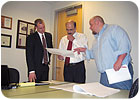
Dan
Watkins, a Bornquist sales engineer (left), discusses the details of a school
project with Paul Ghassan, P.E., (center) and Matt Wickstrom of CCJM Engineers,
Ltd., which is based in Chicago.
Here To Learn and Serve
For many years, Bornquist has been known for its engineering excellence, which it offers as a way to generate more volume for its vendors. The company has a four-person sales engineering staff, which helps contribute to the firm’s success at selling specified and engineered products. These staff members make up part of Bornquist’s outside sales department, which totals 20 people.Hultgren says that the number of Bornquist salespeople that are graduate engineers continues to increase. Some also have professional engineering licenses, which the company encourages-not only because it’s good for the company, but also because it’s good for the individual.
In addition, several Bornquist employees are heavily involved with local trade associations, such as the American Society of Plumbing Engineers (ASPE), American Society of Heating, Refrigerating and Air-conditioning Engineers (ASHRAE), American Society of Sanitary Engineering (ASSE), Radiant Panel Association (RPA) and Refrigeration Service Engineers Society (RSES). “We have had our employees serve as local chapter officers in most of these organizations. We’re very proud of that,” says Hultgren.
With the exception of Kaulas, all of the engineering sales staff in the Chicago office spent three months at The Little Red Schoolhouse (LRS) shortly after joining Bornquist. The schoolhouse is an intensive training school run by Bell & Gossett and located in Morton Grove, IL. While attending this school, students learn the ins and outs of pumping/piping systems, steam systems, heat transfer, controls and a number of other system-related subjects.
“During that three-month training, you develop relationships by living with others from various rep firms nationally and internationally,” says Dave Everhart, who attended the LRS in 1988. He has spent 19 years with Bornquist and is HVAC sales manager. “You must practice developing relationships, just like you practice the technical knowledge aspects. The foundation of serving our customers comes from that.”
After leaving the school, the Bornquist employee then learns the “nitty-gritty” of the plumbing/HVAC industries by working with the service personnel and take-off/quotation department, traveling with salespeople and attending all training programs offered by other manufacturers Bornquist represents. Only then will the employee be allowed to answer the phones and address customer questions.
“We have no problem sending our entire staff to training in order to keep them up to date. There’s quite a cost for this, but the results are worth it. After all, we need to be the experts at all levels of the company,” Hultgren says. “A person spends several years as an inside sales person, getting to know the product, the applications, and the customers before we move them to outside sales, because we don’t want to put someone on the street who isn’t an expert.
“All inside sales people are proficient in what they do, but they also know what they don’t know and when they need to turn it over to the outside people.”
Employees are trained as system specialists in two ways. The first is having a complete system-wide view of a project. “We’re never looking at a stand-alone product; everything leads to something else. This gives us the ability to help our clients with everything from boilers to pumps to fan coils to water heaters to variable speed operations, and so on. That’s helpful to engineers because we’re able to go in and say, ‘this has an impact on that, and we can analyze what that impact will be.’ ”
The second aspect of system specialty is related to how Bornquist actually sells products. “It’s a complex sales system, very specific to the local markets. Even though we’ve been doing it a long time, and we think we do it well, we’re always looking to improve our value to the engineer, contractor, wholesaler and owner,” notes Hultgren, who has been in the industry since 1978 and with Bornquist since 1983.
“The unique thing we bring is one-source responsibility-we sell systems,” says John Berg, CEO. “Engineers prefer to look to one person to be that point of contact.”
“We’re unique in terms of our system knowledge-how we approach the problems engineers face,” explains Vice President Eric Urbaniac, who has 37 years’ experience in the plumbing industry, the last 23 as a Bornquist employee. “We know a little more about the systems that our products go into so that we’re able to advise the customer beyond the simple nuts and bolts of a pump, for example.”
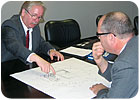
Consentini
Associates, Inc.’s project manager Robert D. Jackson, CIPE, talks at length
with Bornquist Sales Engineer Mark Kaulas about the plumbing design challenges
involved with the Chicago Spire, which will rise to a
height of 2,000 feet when completed in 2011-making it North America’s tallest
structure and the world’s tallest all-residential building. All photos by Jim
Camillo.
“All of these items are important to an engineer when deciding on a design and specifying specific manufacturers’ products,” says Hultgren. “We try to conserve an engineer’s time by selecting and sizing the proper equipment with the given set of conditions and by providing options. The product lines we represent have helped us take a big-picture look in order to provide the engineer with the best possible choices.”
Because the Chicago staff has a smaller geographical territory than its East Moline, IL, counterpart, it can “layer” its sales coverage and focus on types of customers. For example, a separate salesperson might call on mechanical engineers and plumbing engineers in the same geographical area, but each effort supports the other efforts. “We never look at sales in any single area as a vacuum. Each and every sales call has an impact on the total market, not just one part of it,” says Hultgren.
“There’s a real partnership between the engineer and our engineering sales staff,” says Dave Bernholdt, sales manager of the plumbing division. “Our engineers help them on the design-build side of the job, and we help everyone work together as a team at all levels of the project to provide the best product support in the marketplace.”
Engineers need the information Bornquist provides to be accurate every time, Hultgren says. The firm also knows that engineers work with a lot of time constraints and that saving time means saving money.
“We can submit data electronically or by paper, whichever the customer prefers. But it can all be done very quickly,” says Hultgren. “We’re able to process submittals electronically and within two days get them back to our customer because we have two people who are dedicated entirely to doing that,” adds Dave Everhart.
“We get them any support documentation, such as specs and CADD details, that they need for product selection,” says Dan Watkins. “We also help with any designs outside of what they’d normally do. For example, some engineers are not familiar with radiant floors, so we’ll walk them through a design and give them some rules of thumb on the typical things that go into a radiant system. It’s a soft-sell process. The engineers know that they can come to us for support later on because we were involved in the design process, and we stand by what we do.”
To further benefit their engineer clients, several years ago Bornquist took all of the specifications for all of the manufacturers’ products they represent and put them in CSI Format and posted them on the Bornquist Web site. “Specifying engineers want this standardized type of format and they want it easily accessible,” says Urbaniec. “Our Web site also has isometric drawings of the products and systems we represent, as well as specific password-entry pages for the engineer, contractor and wholesaler.”
“At the same time,” notes Hultgren, “if the product is oversized, we call the engineer and tell them that the model they called for is beyond capacity for what is needed. They appreciate our follow-up.”
Another way Bornquist helps engineers is by fabricating pumps and other equipment to ensure delivery of specified products to the installing contractor in a timely manner. Hultgren explains. “We can often get a stalled job moving forward very quickly, in just a few hours. This again helps the customer know that if they specify our products, they’re getting the backup they want.”
As the project proceeds, Bornquist staff members are always there to provide recommendations. “We must be able to quickly determine what that building needs, and sometimes we haven’t seen any drawings,” says Everhart. “Or a client might send an incomplete set of drawings out to the field to our plan and spec department to do an estimate.” Often, before the final version of the drawings are done, Everhart says, the engineer will ask Bornquist’s staff to come in and look at the drawing, specifically seeking their opinion of details like the piping arrangement, sensor locations for variable speed applications, condensing vs. non-condensing boiler suggestions, air separator location, etc.
“Whenever a job isn’t running the way the engineer expected, he knows he can come to their salesman at Bornquist and be confident we’ll look at the job, help figure out the problem and resolve it.
Everhart notes that they also get general and application questions about products Bornquist doesn’t even represent. “In those cases, we’ll either provide info or give the name of someone who can help them get their answer.”
“In a nutshell, we provide key information. Engineers are always going to have questions and they look to us to provide answers,” says Urbaniec. Hultgren points out that Bornquist is not one to overlook contractors when it comes to engineering design. “They do a lot of design work, and there are many cases where the contractor and engineers are working together.”
As if all of the above wasn’t enough, Bornquist also runs technical schools at various locations in its market areas for consulting engineers, chief engineers, contractors and wholesalers. “We do more technical schools, presentations and seminars than ever. We provide Lunch & Learn seminars at the engineers’ offices, in-house seminars here, seminars for association meetings and seminars at places like the Metropolitan Club on the 67th floor of the Sears Tower. The L&Ls provide design-based education and focus on solutions to engineers’ problems.”
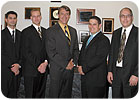
The Engineering Sales Team
Current/Future Challenges/Opportunities
Currently, the HVAC division accounts for about 75% of sales, although Hultgren says that company growth is evenly matched between HVAC and plumbing. “Over the next two years, I expect the growth in plumbing to be significant,” Hultgren states. “We have focused on new opportunities in the engineered plumbing-related markets, particularly highly engineered products.”“We’ve taken on products with solid potential in the territory,” says Urbaniec. “We won’t take on a line unless we know we can do the right job for that manufacturer,” Hultgren adds.
In the last few years, Bornquist has added to its product/application specialists as a way to ensure a product line’s success. Hultgren says that, aside from inside to outside sales assignments (which are intentionally kept loose), Bornquist prefers to have teams that change players. “This lets our specialists move from job to job, regardless of who is the salesperson of record for the order. It keeps a company-wide teamwork attitude going.”
The challenges Bornquist faces as a company also present important growth and service opportunities: changes in technology, industry consolidation and economics, and new products and design concepts (including Green Design).
“One of the great things about our investment into new technologies is our sales per employee measurement, which has grown significantly since 2001,” Hultgren says. “We are a more efficient company, which helps us put new people in the right places and lets our salespeople connect electronically to the offices, leaving them more time to do the important thing-meet with customers.”
Industry consolidation and/or manufacturer consolidation has impacted Bornquist, Hultgren admits, but says being a successful rep firm means being committed to always finely tuning its coverage to meet local needs. “Each market is unique, and if blanket rules are applied too often, you can miss your best opportunities. Local reps provide the finely tuned marketing needed to succeed in multiple territories.”
Educating engineers about the changing economics of the industry is another growth opportunity, notes Kaulas. “Even though variable speed drives aren’t new, the pricing is. Years ago you might not have used the drive because of the cost involved, but the new economies can let you use a drive on almost every application. Another example is brazed plate heat exchangers. The cost of that product has come down so dramatically we want engineers to know it’s cost-effective to use them for particular applications.”
Everhart says that many products associated with high-efficiency equipment are brand new to the market-and that the engineer may wish to rely on Bornquist’s expertise to properly achieve and apply that efficiency. “LEED (Leadership in Environmental and Energy Design) is primarily an architectural standard, but the mechanical systems are largely influenced by that standard. We help make sure that the job the engineer promised to deliver is a LEED-certified project that will meet the efficiency performance requirements.”
Green design is really picking up a lot, according to Dan Watkins. “A lot of engineering firms that never did green before are calling up and saying, ‘I have a LEED project but never did one before-can you help?’” To help his clients get up to speed on green design, Watkins is gearing up to take the LEED AP exam later this year.
When I ask the sales engineers to talk about specific LEED projects, Kaulas discusses some Chicago greywater projects he’s worked on the past 12 months. “We had a couple jobs where we recycled the water from lavs and showers and reused that water to flush toilets. To my knowledge, that’s the first and only job like that in Chicago. Then we had a couple greywater-harvesting jobs, where we’re taking the rainwater off the roof and using it, in one case, for irrigation, and in another case, for flushing the toilets. And both those jobs were for specifically LEED credits.”
Kaulas also pointed out that he never supplied a solar unit water heater for a job until two years ago. “Now we’ve done eight or 10 jobs since then. That aspect has really taken off, and it’s going to grow rapidly over the next several years.”
Besides presenting technical seminars on energy-efficient products such as solar, water heating, boilers and variable speed drives, Bornquist also focuses on other important LEED-related issues, such as payback time and helping engineer clients obtain points. “How long will it take for something to pay for itself? That’s a common question from the engineer, so we help them decide which technology is most appropriate for their project,” says Everhart.
“Usually, the engineers are aware of what they need to do to get LEED credits,” notes Kaulas. “They’ll tell us what they need in order to achieve a certain number of points within the building. Our focus is to help them flesh out their ideas and work with them to help them achieve their goals.”
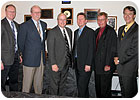
The Sales Management Team
One More Thing"
Bornquist sees itself as the face and voice of the manufacturers they represent, and Hultgren says the company always makes sure its employees understand this.“A few years ago, the president of one of our key manufacturers was playing golf in Chicago. At a par-three hole, the group behind him caught up. In this group was a Chicago-area contractor. Seeing that manufacturers’ logo hat, logo golf balls and logo towel, the contractor responded, ‘Oh, I see you work for Bornquist.’ We like that. It means that we’re doing our job as the face and voice of the manufacturer in our territory.”
Another way that Bornquist makes sure its employees always keep the customer’s needs in the forefront is through internal promotional sales themes.
“This year, it’s ‘Think One.’ The theme came from the idea that if we take one more step for the customer, great things can happen. One more sales call, one more introduction within a customer’s office, one more product line presented. When you do the math, it leads to a big difference for us,” says Hultgren.
“We’re listening very hard to our customers and staying with them every step of the way to help them get where they want to go. Our future direction is based on where our customers are going.”
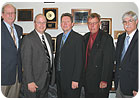
The Board of Directors
Sidebar: A Brief Overview of Bornquist Inc.
History: Bornquist Inc. was founded by Baron Bornquist in 1937, selling Bell & Gossett exclusively. His son, George, became president in 1952, and ran the company until 1970, when Bud Herrick and Ron Cole took over. Herrick and Cole added a number of new product lines as the applications became larger and more varied. They ran the company until 1984, when Steve Thompson became president and CEO. Thompson began the divisionalization process, adding many new lines.The company acquired Lavaty Engineering Corp. in March 1988 and Whesco Inc. in January 1996, both plumbing-oriented companies, which formed the basis of its plumbing division.
Lavaty Engineering brought the company glass pipe and fittings used on drain lines for acid and chemical waste handling. With Whesco, Bornquist added gas-fired water heaters, tanks, oil/water separators and grease traps.
The John A. Sandberg Co., a 40-year-old company based in East Moline, IL, specializing in hydronics and architectural products, was purchased in August 1997. Benchmark Showcase was acquired in March 1999.
Corporate Structure: Thompson retired in 2006 and a new corporate structure was put in place. It includes:
Mike Hultgren, President;
John Berg, CEO;
Dave Everhart, HVAC Sales Manager;
Dave Bernholdt, Plumbing Sales Manager;
John Overstreet, Sales Manager, Sandberg Division (East Moline, IL);
Eric Urbaniec, VP/GM, Sandberg;
Arnie Zehner, VP-Contractor Sales;
Jim Moore, VP Administration;
Dennis Casimiro, General Office Manager.
“In every instance, the new leadership came from within the company-something that will continue in the future,” says Hultgren.
The company has two locations-Chicago and East Moline, IL-each of which has a full inventory of parts and products and operates its own sales and support functions, with mutual support. Bornquist has two divisions in Chicago (HVAC and plumbing), and two divisions in East Moline (mechanical and architectural). The point of the divisions is to provide focused, market-specific coverage.
Total Employees:60 [includes 20 outside sales, 17 support staff, 10 inside sales, five warehouse, three in service, three in the take-off department and two sales administrators]
HVAC Manufacturers Represented:ITT Bell & Gossett; ITT Domestic; ITT Hoffman; ITT McDonnell & Miller; Cemline; Danfoss Drives; Danfoss Heating; Patterson-Kelley Boilers; Pep Filters; Pure Humidifiers; Rittling/Panel Radiator; tekmar Controls; Twin City Hose; Viessmann Boilers; Watts Radiant; Weiss Instruments; and Bornquist Packaging.
Plumbing Manufacturers Represented:Bell & Gossett/ITT Industries; Barnes; Cla-Val; Cemline Corp.; Danfoss Drives; Holby; Highland Tank; Karp; Pep Filters; Reco USA; Schott Scientific Glass Inc.; Stiebel Eltron; Weiss Instruments, Inc.; and WaiWela.